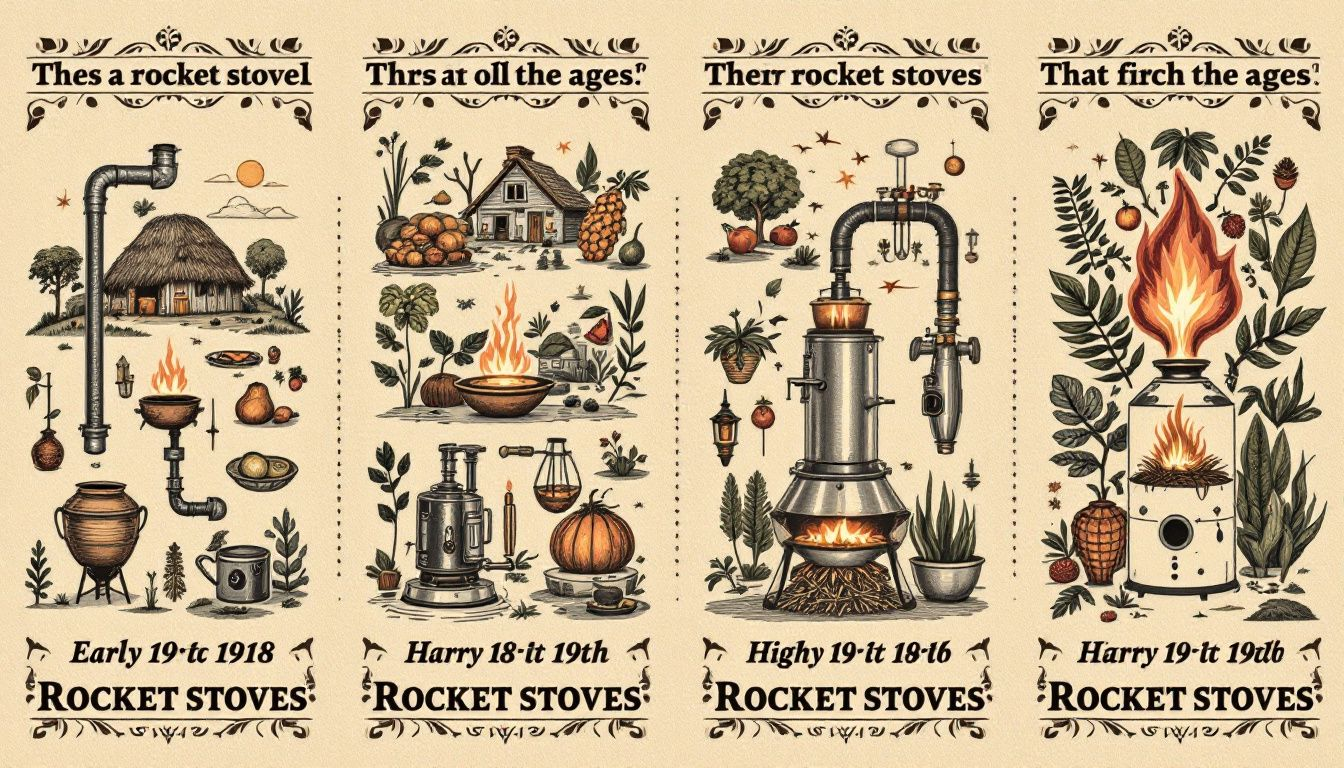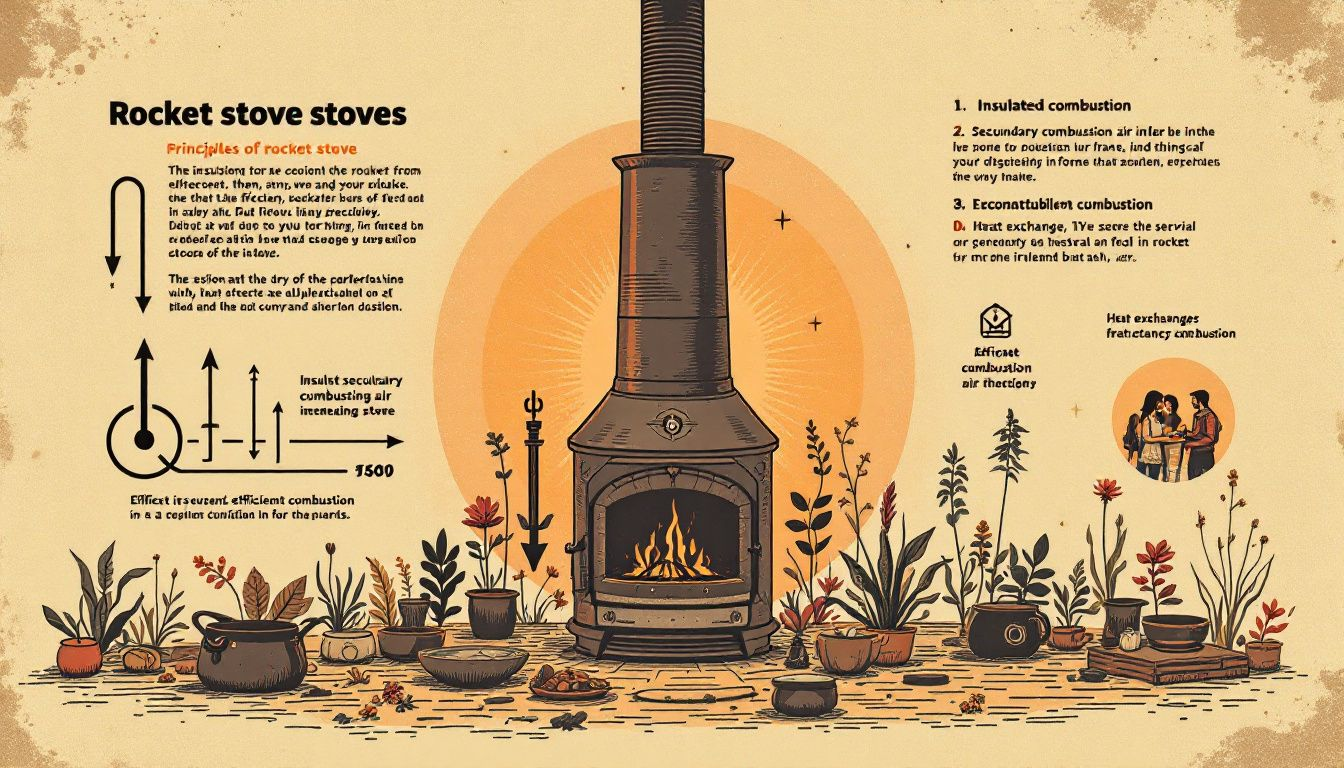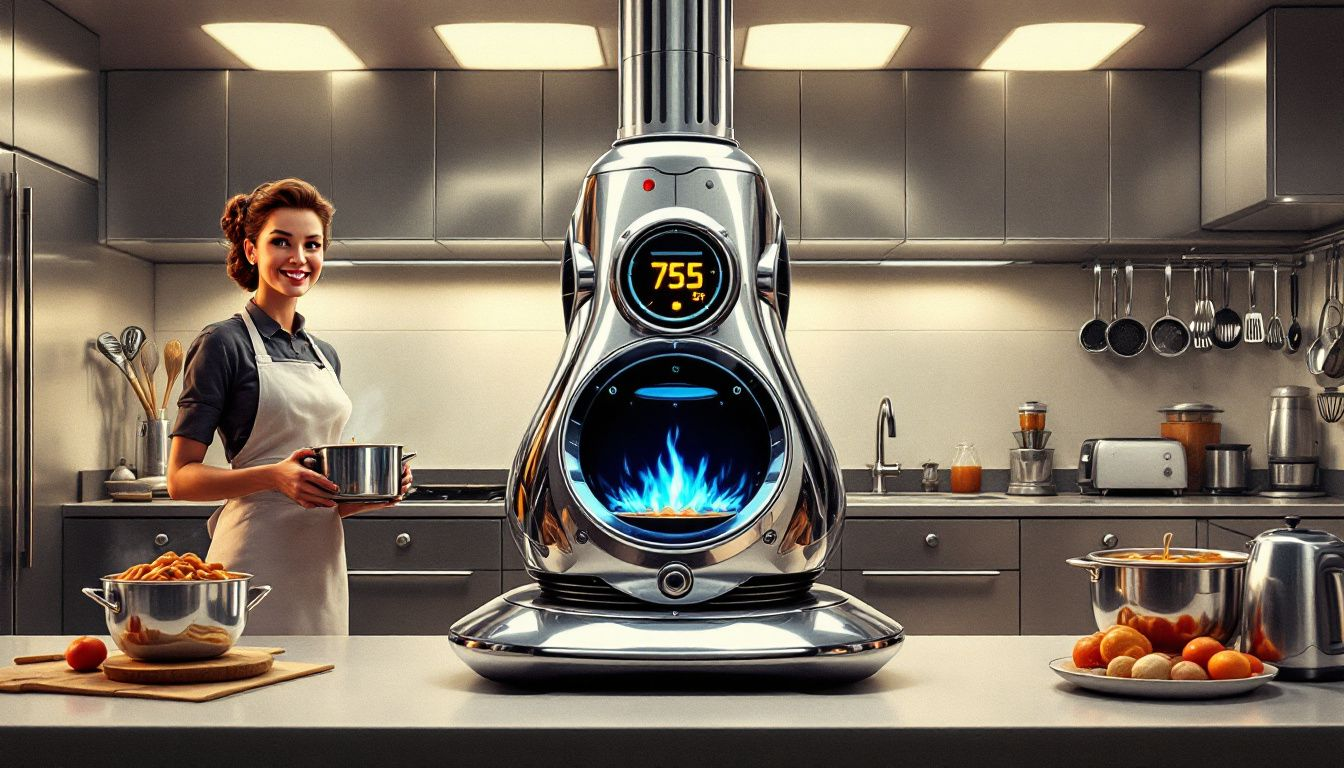What Is Rocket Stove: Efficient, Eco-Friendly Heating and Cooking Explained
A rocket stove is a wood-burning stove that is designed for efficient heat generation with minimal smoke. It uses a unique design to achieve near-complete combustion and lower emissions. In this article, we will explain what is rocket stove, how it works, its design, and its benefits.
Key Takeaways
-
Rocket stoves offer an efficient and eco-friendly solution for heating and cooking, achieving up to 93% fuel efficiency and significantly reducing emissions.
-
Their simple yet effective design allows for portable use in various applications, including emergency preparedness, indoor cooking, and outdoor activities.
-
Building a rocket stove can be an affordable DIY project, promoting sustainability by utilizing recycled materials and minimizing fuel costs for households.
Understanding Rocket Stoves

A rocket stove is a highly efficient wood-burning stove that maximizes heat output while minimizing smoke production. Traditional wood stoves often experience incomplete combustion due to insufficient oxygen intake, leading to smoke and unburned fuel, whereas rocket stoves achieve near-complete combustion, leading to less fuel waste and lower emissions.
The basic design includes a combustion chamber, an insulated burn tunnel, and a chimney, all working together to create a highly effective heating and cooking solution.
Basic Design
The rocket stove’s design is ingeniously simple yet highly effective.
At its core, it consists of:
-
a combustion chamber, where the fuel burns, generating the heat needed for cooking or heating
-
a burn tunnel, which facilitates airflow, ensuring that the combustion process remains efficient
-
a chimney, which helps to direct smoke away from the cooking area
This design allows for efficient fuel use and effective heat generation, providing all that heat.
The chimney plays a crucial role by allowing hot air to escape quickly, drawing in fresh air for combustion and improving overall efficiency. This design not only maximizes heat retention but also ensures that the stove operates at high temperatures, making it an incredibly efficient wood-burning stove.
How It Works
Rocket stoves operate on a simple yet effective principle. The efficient combustion process creates a powerful airflow that results in a distinct 'fire roaring' sound, enhancing the cooking experience and indicating effective combustion. Air is sucked from underneath a grate, over the fuel, and through the flue, ensuring a steady airflow that is essential for efficient combustion. The burn tunnel is where volatile compounds combust, significantly increasing heat production and ensuring that almost all the fuel is burned.
Efficient air intake and complete combustion are critical for optimal heat generation and reduced emissions in rocket stoves. This design allows for a powerful updraft that pulls in more air for combustion, ensuring a clean and efficient burn. The result is a stove that not only produces more heat but also emits far less smoke compared to traditional wood-burning stoves.
Historical Background

The rocket stove was developed in 1982 by Dr. Larry Winiarski at the Aprovecho Institute to enhance wood-burning efficiency for cooking. The concept builds on earlier designs, such as the VITA stove, and incorporates principles from the Argand lamp, patented in 1780, which introduced a glass chimney to enhance airflow. Ancient Roman systems, particularly hypocaust technology used for heating and cooking, also influenced the design.
The primary goal of the rocket stove was to address health issues related to smoke inhalation from traditional wood stoves, particularly in developing countries. Over the years, the design has evolved to include applications for both cooking and heating, leading to innovations like the rocket mass heater.
Modern Applications
Rocket stoves have found their place in a variety of modern applications, from home heating and cooking to emergency preparedness. Innovations in rocket stove technology include portable designs and integrated cooking systems tailored to specific regional needs.
Educational programs teach communities how to build and maintain their own rocket stoves, making this technology accessible to many.
Home Heating
Rocket stoves provide a reliable heat source for home heating, utilizing minimal fuel for maximum heat output. They are not only efficient in heating spaces but also versatile enough to heat water using a smaller amount of wood compared to traditional stoves. This makes them an ideal solution for homes looking to reduce their reliance on electricity and other fuels.
The advantages of using rocket stoves extend beyond mere fuel efficiency. These stoves can be integrated into home heating systems, providing a sustainable and cost-effective way to keep your home warm during the colder months. Their ability to produce high heat from small amounts of wood makes them an excellent choice for those looking to reduce their carbon footprint.
Cooking
Rocket stoves are highly efficient, making them ideal for cooking in both indoor and outdoor cooking settings. A small amount of wood, such as a handful of twigs, can effectively cook an entire meal due to the stove’s efficient design. This not only saves on fuel costs but also minimizes the environmental impact.
One notable example of rocket stove technology in cooking is a specific design for making tortillas, which received the Ashden Award in 2005. This highlights the stove’s effectiveness and versatility in various culinary applications, from boiling water to grilling and roasting.
Emergency Preparedness
Rocket stoves play a vital role in emergency preparedness by providing reliable heating and cooking solutions during power outages. They can be used for a range of applications, including cooking, heating water, and even making purified distilled water.
This makes them an essential tool for any emergency kit, ensuring you have a dependable heat source when you need it most.
Outdoor and Camping Uses
Rocket stoves are incredibly versatile and can be used for various outdoor and camping activities. Their portability and lightweight design make them an ideal choice for backpackers, campers, and outdoor enthusiasts. Whether you’re cooking a meal, heating your tent, or using it as a makeshift grill, a rocket stove can handle it all.
When it comes to outdoor cooking, rocket stoves can reach very high temperatures, allowing for quick and efficient meal preparation. The cooking surface is designed to withstand these high temperatures, making it perfect for cooking a variety of foods, from boiling water to grilling meats. The stove’s ability to produce hot air and distribute it evenly ensures that your food cooks thoroughly and efficiently.
For camping trips, rocket stoves are a sustainable and eco-friendly option. They can be fueled by small twigs and branches, which are often readily available in natural settings. This not only reduces the need to carry heavy fuel but also minimizes the environmental impact. The compact size and lightweight design make rocket stoves easy to carry and store, making them a great addition to any camping gear.
Key Features of Rocket Stoves

The key features of rocket stoves include their fuel efficiency, complete combustion, and portability. The combustion chamber is heavily insulated to maintain very high temperatures and maximize heat generation. The design allows for efficient cooking at high temperatures, making them suitable for both indoor and outdoor use.
These features make rocket stoves an excellent choice for anyone looking for a reliable and efficient heating and cooking solution.
Fuel Efficiency
Rocket stoves achieve a high level of efficiency and produce very little smoke compared to traditional wood-burning stoves. They can achieve an efficiency of up to 93%, significantly reducing wood consumption and leading to substantial savings. This high efficiency not only lowers fuel costs but also reduces the environmental impact by cutting down on deforestation.
Using rocket stoves can lower deforestation rates, as they require less wood for the same heat output. This makes them an eco-friendly option for those looking to reduce their carbon footprint and contribute to forest conservation efforts.
Complete Combustion
Rocket stoves are designed to achieve nearly complete combustion, resulting in higher efficiency and less smoke compared to traditional wood stoves. This design ensures that almost all the fuel is burned, producing more heat and fewer emissions. The use of rocket stoves can lower the release of CO2 into the atmosphere and substantially mitigate the production of black carbon, which contributes to climate change.
These stoves emit considerably less smoke and harmful gases compared to traditional wood-burning stoves. This not only improves indoor air quality but also reduces the health risks associated with smoke inhalation.
Portability
Rocket stoves are designed to be lightweight, making them easy to carry during outdoor activities. Their compact design makes them easily transportable, ideal for camping and other outdoor adventures.
This portability, combined with their fuel efficiency, makes rocket stoves a popular choice among outdoor enthusiasts.
Hot Air Distribution and Efficiency
Rocket stoves are designed to distribute hot air efficiently, making them an excellent option for both space heating and cooking. The stove’s combustion chamber is engineered to produce hot air, which is then channeled through the burn tunnel and chimney. This hot air is released through the cooking surface, allowing for efficient cooking and heating.
The air intake system of a rocket stove is crucial for maximizing airflow, which in turn enhances combustion efficiency. The burn chamber is designed to achieve complete combustion, significantly reducing the emission of harmful gases. This efficient hot air distribution not only makes rocket stoves effective for space heating but also ensures that cooking is quick and energy-efficient.
Fuel efficiency is another key advantage of rocket stoves. By producing hot air and distributing it effectively, these stoves reduce the amount of fuel needed for cooking and heating. This makes them an eco-friendly choice for those looking to minimize their energy consumption and environmental impact.
Benefits of Using Rocket Stoves

The benefits of using rocket stoves are numerous. They significantly cut down on indoor air pollution compared to traditional stoves. Rocket stoves play a significant role in promoting sustainability by reducing deforestation and improving health outcomes in developing regions.
They can be constructed using recycled materials, making them a sustainable and environmentally friendly option for cooking and heating.
Environmental Impact
When operating correctly, a rocket stove produces mainly carbon dioxide as exhaust, indicating efficient combustion. The design allows for higher oxygen flow, promoting thorough combustion and minimizing harmful emissions. This results in little to no smoke, significantly reducing air pollutants.
Overall, rocket stoves present a more eco-friendly alternative to traditional wood-burning methods by reducing carbon footprints and harmful emissions. They are highly efficient, capable of producing substantial heat while using minimal fuel.
Cost Savings
Building and using rocket stoves can lead to considerable savings on fuel costs, as they are designed to use less wood or other combustible materials. Households using rocket stoves can see a reduction of up to 50% in their fuel costs due to increased efficiency.
This makes them a cost-effective option for anyone looking to save on heating and cooking expenses.
Versatility
Rocket stoves are incredibly versatile and can be utilized for cooking, heating, and even powering water heating systems. They are adaptable for various cooking methods, making them effective for different regional culinary practices.
This versatility makes rocket stoves a valuable addition to any home, especially those with limited fuel resources.
Building Your Own Rocket Stove
Building your own rocket stove is a rewarding project that promotes sustainable cooking and heating. The process can be achieved using inexpensive materials like cardboard tubes and reinforced concrete. This not only makes it an affordable option but also allows for customization to suit specific needs.
In the following subsections, we will guide you through the materials needed and the step-by-step construction process.
Materials Needed
To build a rocket stove, you will need some common materials, including a #10 can and two large 28 oz cans for the stove’s framework. Other essential materials include fiber-reinforced cement mix, perlite, and a cardboard mailing tube for insulation.
Utilizing recycled materials can enhance the stove’s sustainability and reduce costs.
Step-by-Step Guide
The first step in building a rocket stove is to mark and cut a center hole in the lid of the #10 can. Next, cut holes in the cans to create airflow and insert the inner components. Ensure that the air and fuel chambers are designed to allow adequate airflow for efficient combustion.
After cutting the holes, pack insulation tightly around the inner can to enhance heat retention. Finally, add sand or rocks at the base to balance the stove during use.
With these steps, you’ll have a functional and efficient rocket stove ready for use.
Safety Considerations
When using a rocket stove, safety is paramount. Ensure the stove is placed on a flat, stable, and non-flammable surface to reduce the risk of tipping and fire hazards. Always keep children and pets at a safe distance to prevent accidental burns or injuries. Additionally, avoid placing any flammable materials near the stove to minimize the risk of accidental fires.
Following these safety guidelines will ensure a safe and enjoyable experience with your rocket stove.
Maintenance and Upkeep
To ensure that your rocket stove continues to function efficiently, regular maintenance and upkeep are essential. The combustion chamber and burn tunnel should be cleaned regularly to maintain complete combustion and minimize the emission of harmful gases.
The air intake system also requires regular cleaning to ensure maximum airflow and combustion efficiency. Keeping the cooking surface clean is important for maintaining its ability to distribute hot air effectively. Regular maintenance not only extends the life of your rocket stove but also ensures it operates safely and efficiently.
Following the manufacturer’s instructions for maintenance and upkeep is crucial. This includes periodic checks and cleaning routines that help keep the stove in optimal condition. By taking these steps, you can enjoy the benefits of your rocket stove for many years to come.
Future of Rocket Stoves

The future of rocket stoves is bright, with ongoing research and development aimed at enhancing their efficiency and sustainability. Adaptations of rocket stove designs in different regions, such as Indonesia, are being made to enhance local agricultural practices. Researchers are also working on improving heat resistance in new materials to ensure durability during prolonged use.
As rocket stoves continue to gain popularity, their impact on sustainable cooking and heating practices worldwide cannot be overstated. The design of rocket stoves allows for prolonged energy release, making them efficient for heating and cooking with minimal fuel consumption. This growing interest highlights the potential of rocket stoves to revolutionize the way we approach energy use in our daily lives.
Summary
Rocket stoves offer a compelling solution for efficient, eco-friendly heating and cooking. Their unique design maximizes heat output while minimizing smoke production, making them a superior alternative to traditional wood-burning stoves. From home heating and cooking to emergency preparedness, the applications of rocket stoves are vast and varied.
In summary, the benefits of rocket stoves include significant environmental impact, cost savings, and versatility. By adopting rocket stove technology, we can reduce our carbon footprint, save on fuel costs, and enjoy a reliable heat source for various applications. Embrace the future of sustainable living with rocket stoves and make a positive impact on both your life and the environment.
Frequently Asked Questions
What is the life expectancy of a rocket stove?
A well-built rocket stove can last for many years, especially if made from quality materials like stainless steel or thick metal. Investing in a solid design guarantees you’ll enjoy its benefits for a long time!
What is the difference between a rocket stove and a wood stove?
The key difference is that a rocket stove promotes nearly complete combustion, resulting in less smoke and soot compared to a traditional wood stove. This efficiency not only makes it cleaner for the environment but also maximizes your fuel usage!
What is a rocket stove?
A rocket stove is an incredibly efficient wood-burning stove that enhances heat output and reduces smoke, making it an eco-friendly choice for cooking or heating. It's a fantastic way to enjoy warmth and sustainability!
How does a rocket stove achieve high fuel efficiency?
A rocket stove achieves high fuel efficiency by promoting efficient air intake and nearly complete combustion, minimizing fuel waste and emissions. This clever design means you can cook more sustainably and effectively!
Can I build my own rocket stove?
Absolutely, you can build your own rocket stove! It's a fulfilling project that only requires simple materials like cardboard tubes and reinforced concrete.
